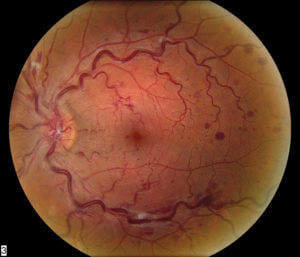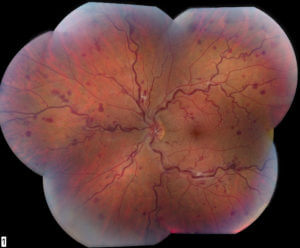As a national leader in clinical research,
Wills Eye conducts the latest clinical trials for central retinal vein occlusion.
What is Central Retinal Vein Occlusion (CRVO)?
Arteries carry blood from the heart to various body parts, and veins return it. The retina has one major artery and one major vein, which is called the central retinal vein. Sometimes this vein can be blocked suddenly to some degree by a blood clot.
What Causes It?
In most cases, an underlying cause is not found and we never know why it happens. It is more common in patients with glaucoma, high blood pressure, arteriosclerosis, and diabetes than it is in other people.
Why does it cause decreased vision?
When the central retinal vein is blocked, the circulation through the retina is greatly reduced. There is often some degree of fluid back-up and swelling of the center of the retina which is called macular edema. When this happens, the retina doesn’t function well, and the vision becomes blurred.
What is likely to be the visual outcome?
A few patients, with time, have a spontaneous improvement in vision. In most cases, however, the vision remains the same or worsens without treatment. The ultimate visual outcome cannot be predicted for anyone. In general, the more severe the occlusion and associated macular edema, the less likely the vision will improve spontaneously.
Effective Treatment Options for CRVO
Treatment options proven to be effective in reducing macula edema and improving vision to some degree include medicines injected into the eye such as VEGF blockers (Lucentis and Avastin) and steroids (Triamcinolone and Ozurdex). Laser, eye drops, and glasses do not help to improve vision.
Request an Appointment TODAY
If you would like to speak with a Wills Eye representative for help finding a retina physician
CALL 215-928-3444


Why are follow-up visits necessary?
Patients with macular edema need ongoing follow-up and regular injections in order to preserve vision. In about one-third of all cases, a severe form of glaucoma called NEOVASCULAR GLAUCOMA develops and the eye pressure can rise to very high, dangerous levels. If it looks like this is about to occur, a laser treatment is necessary. Often a VEGF blocker injection into the eye also may be needed. These treatments can help to prevent or control the glaucoma but they do not improve the vision when it is affected by high eye pressure.
MEET WILLS EYE RETINA DOCTORS
Are there any restrictions or precautions?
There is no reason to limit one’s activities, to avoid reading, to avoid watching TV, etc. However, when one has blurred vision in one eye for any reason, one’s depth perception is hampered. To the degree that this is true, one should be very careful doing anything which requires the ability to judge distances such as working around machinery, climbing on ladders and scaffolds, pounding nails, pouring hot liquids, and driving. It is relatively uncommon for a similar process to affect the other eye, and blurry vision in one eye does not in any way harm the “good eye”.
When should a patient come back before his/her appointment?
A patient should come back sooner than scheduled if there is a marked decrease in vision or if the eye becomes painful.
FOR MORE INFORMATION ON CENTRAL RETINAL VEIN OCCLUSION OR TO SEE A RETINA SPECIALIST AT WILLS EYE HOSPITAL, PLEASE CALL US AT 215-928-3444 OR FILL OUT OUR MAKE AN APPOINTMENT FORM.
